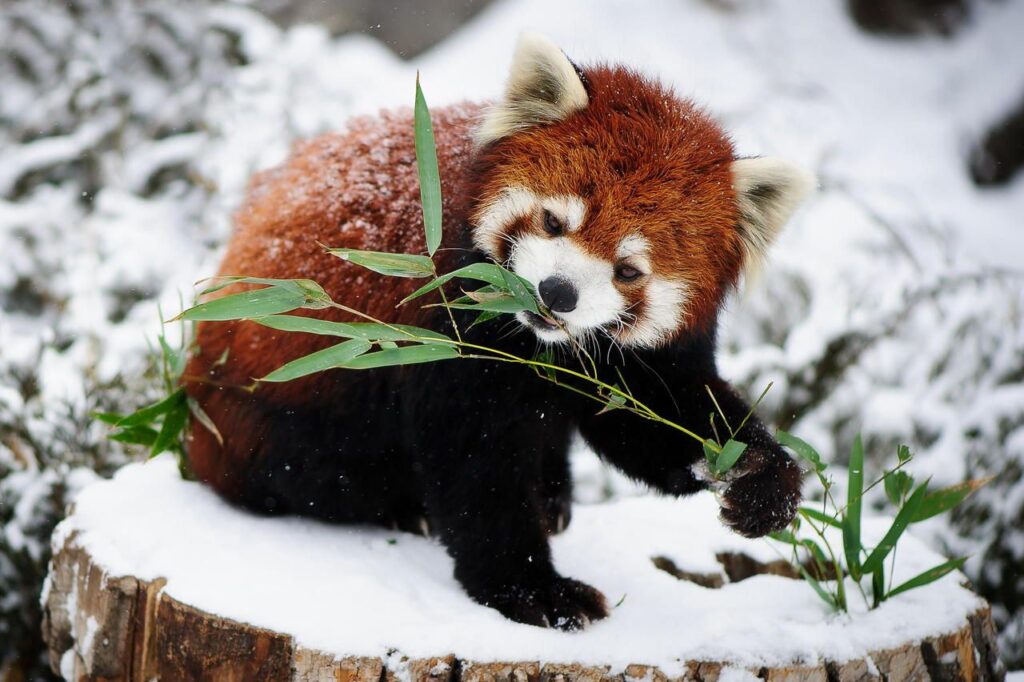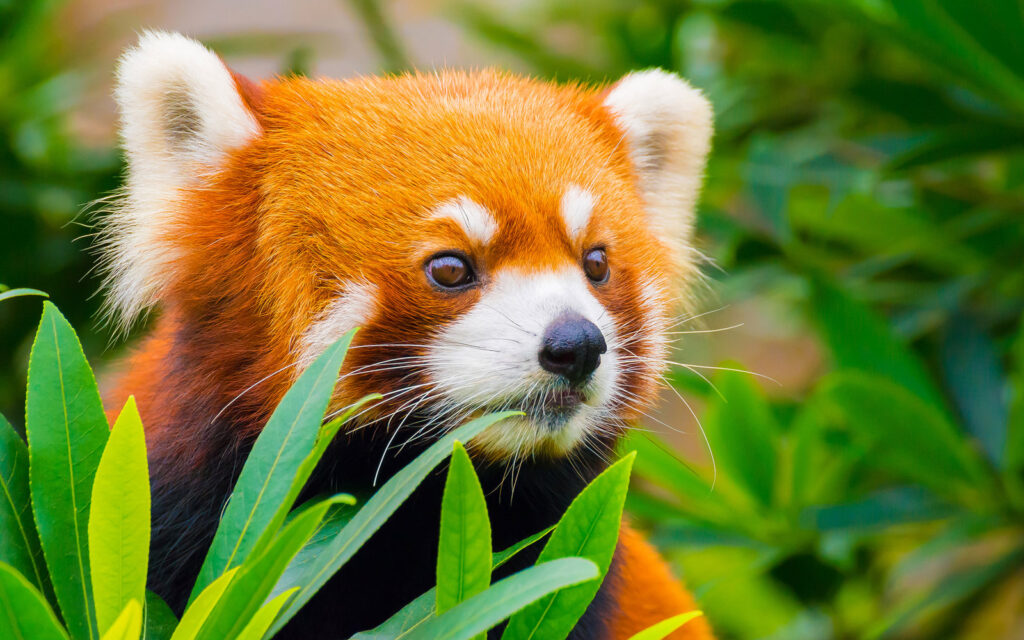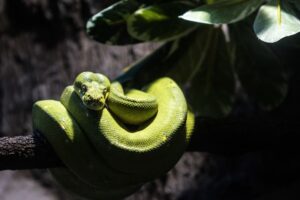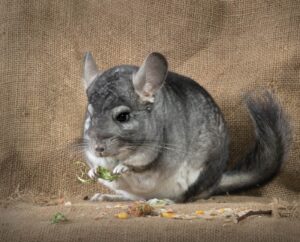Table of Contents
ToggleIntroduction
In the mystical realm of Eastern Himalayan forests, where mist veils the trees and the chill of high altitudes gently brushes against the foliage, resides a creature of vibrant beauty and curious demeanor – the red panda.
Despite the name suggesting kinship with the well-known giant panda, the red panda is a unique species with a captivating story. Not as big but equally grand in its allure, the red panda’s radiant fur and playful antics have fascinated scientists and enthusiasts alike.
Often dubbed the “firefox” due to its reddish-brown fur, the red panda is a feast for the eyes and a vital thread in the intricate web of its ecosystem. As we embark on this journey to unravel the life, habits, and mysteries surrounding this incredible mammal, it becomes evident that the red panda is much more than just another forest inhabitant.
Physical Characteristics
A Radiant Mammal
The red panda, with its unique blend of colors, patterns, and features, is a fascinating subject of study regarding mammalian physiology. Whether it’s their luxurious fur that inspired the moniker “firefox” or their agile bodies that easily navigate the high trees, every aspect of their physical make-up is an evolution-driven marvel.
Size and Weight
The red panda is not particularly large, significantly when one contrasts it with other forest mammals. An adult red panda typically weighs between 2.2 to 6.2 kilograms (4.8 to 13.7 lbs). When measured from head to tail, their length ranges from 80 to 100 centimeters (31 to 39 inches). Interestingly, their lush and long seats make up almost half that length!
The Signature Fur
The red panda’s coat is nothing short of spectacular. It boasts a deep reddish-brown hue on its back and black on its underparts. This coloration provides the dual advantage of warmth during the chilly mountain nights and camouflage amidst the dense forest and fallen leaves.
Its thick and woolly fur provides ample insulation against the cold of its high-altitude habitat. Their bushy tails aren’t just for show; they wrap them around their bodies during rest, acting as a cozy blanket.
Face of Innocence
The face of a red panda looks like it’s been painted by nature’s finest artist. Their white snouts and ears contrast beautifully with the deep colors of their coat. The dark patches around their eyes have drawn comparisons to the ‘masks’ seen in raccoons, adding to their allure.
Their eyes, with round pupils, are adapted for both daytime and nocturnal activities, hinting at their crepuscular nature. Whiskers sprouting from their snouts give them a tactile advantage, helping them navigate and explore their environment.
Tail’s Tale
The red panda’s tail is an object of intrigue. Besides aiding balance when they navigate the trees, the tail is a thermoregulator. As mentioned, they often wrap their tails around their bodies for warmth. Moreover, the tail’s alternating red and brown rings offer camouflage amidst the dense underbrush and fallen leaves, making it easier for them to blend into their surroundings.
Diet And Foraging Behavior
Primary Diet: Bamboo
The red panda’s diet is predominantly bamboo-based. While they can eat the entire bamboo plant, they prefer tender shoots and leaves. This dietary choice adapts to their natural habitat, where bamboo forms a significant part of the vegetation.
Other Dietary Items
While bamboo is a staple in their diet, red pandas also consume various other foods. This includes:
Fruits: Seasonal fruits, especially berries, supplement the red panda’s bamboo-based diet. These fruits provide essential vitamins and sugars.
Acorns: Rich in fats and proteins, acorns are another occasional food source for red pandas, providing energy and essential nutrients.
Insects: Red pandas also feed on various insects, which provide them with protein. Insects like ants, termites, and grubs are sometimes consumed when found during foraging.
Small Mammals: Though rare, red pandas are known to hunt and consume small mammals like birds, rodents, and even eggs. These serve as a source of protein and add variety to their otherwise herbivorous diet.
Foraging Behavior and Feeding Patterns
Red pandas have a unique foraging behavior. Since bamboo provides little nutritional value and is tough to digest, red pandas spend a significant amount of their day feeding. They typically forage in the early morning and late afternoon.
Their solid and semi-retractable claws are well adapted to grip bamboo stems, while their strong jaws and sharp molars help them to crush and chew the challenging bamboo shoots and leaves. They use their elongated wrist bone, almost like a thumb, to grasp bamboo while eating.
Red pandas have a modified gut and a short digestive tract that allows them to process large quantities of fibrous bamboo, although with low efficiency. As a result, they need to eat a substantial amount of bamboo daily to extract the necessary nutrients.
Habitat And Distribution
Sanctuary in the Skies: The Red Panda’s Home
The very essence of the red panda is intricately intertwined with the landscapes it inhabits. Treading softly through moss-laden grounds and skirting amidst the thickets of bamboo, these creatures are the heartbeats of the Eastern Himalayan forests and southwestern China.
Eastern Himalayas: A Mystical Abode
The Eastern Himalayas, marked by their rugged terrains, snow-capped peaks, and dense forests, provide the quintessential backdrop for most of the red panda population. Here, the woods blend conifers, broadleaf trees, and, most importantly, bamboo.
Nepal: The hilly regions of Nepal, especially the Langtang National Park, serve as critical sanctuaries. The temperate climate interspersed with periods of snow provides the red panda with a challenging and rewarding habitat.
Bhutan: Bhutan’s commitment to ecological conservation is reflected in its pristine forests. Areas like the Jigme Dorji National Park stand as testaments to red panda conservation, with sightings becoming increasingly common due to sustained efforts.
India: The northeastern states of India, including Sikkim and Arunachal Pradesh, have significant red panda populations. The diverse flora of these regions, especially in places like the Singalila National Park, offers a perfect blend for the red panda diet and shelter.
Southwestern China: Forests Steeped in Ancient Secrets
Beyond the Himalayas, the provinces of Yunnan and Sichuan in China stand as pillars for red panda conservation. The bamboo forests here are dense and lush, providing sustenance and cover.
Wolong Nature Reserve: Located in Sichuan, this reserve is famous for giant pandas and hosts a sizable population of red pandas. The mist-covered mountains and bamboo undergrowth create an ethereal habitat.
Gaoligongshan National Nature Reserve: This reserve is a biodiversity hotspot in Yunnan. The red panda thrives here, often spotted navigating the tree canopies or resting amidst bamboo clusters.
Reproduction And Life Cycle
2. Gestation Period
After successful mating, the gestation period for red pandas ranges from 112 to 158 days. This broad range is attributed to a phenomenon known as “delayed implantation.” Once the female’s egg is fertilized, it doesn’t implant in the uterus immediately. Instead, it waits for a period, ensuring that the embryo starts developing at a time that maximizes the chances of the offspring’s survival.
3. Birth and Care of the Young
Females usually give birth to 1 to 4 cubs, though two is most common. The birthing occurs in nests, which the mother makes in tree hollows or rock crevices lined with moss, leaves, and other soft materials.
The newborn cubs are blind, covered in thick fur, and weigh only about 110 to 130 grams. The mother remains in the nest for the initial few days, only leaving briefly to feed. During this period, she protects her cubs fiercely from any perceived threat.
As the cubs grow, they start venturing out of the nest by around three months but continue to nurse until they’re about eight months old. Mothers teach their young vital life skills, including climbing, foraging for bamboo, and identifying threats.
4. Lifespan in the Wild vs. in Captivity
In the wild, red pandas live for an average of 8 to 10 years. However, their life is riddled with threats, ranging from predators like snow leopards and martens to human-induced challenges like habitat loss and poaching.
In captivity, under the care of professionals in zoos and conservation centers, red pandas can live up to 15 years. The controlled environment, devoid of predators and abundant inconsistent food sources, contributes to their longer lifespan. Regular veterinary care and the absence of environmental stressors also play significant roles.
5. Independence and Maturity
Red panda cubs become independent by the age of one year, after which they venture out to establish their territories. Sexual maturity is typically reached by 18 to 20 months for females and 20 to 24 months for males.
Behavior And Social Structure
Diurnal vs. Nocturnal Behavior
Red pandas are classified as crepuscular, meaning they are most active during dawn and dusk. This behavior is a strategy to avoid larger predators active during the day and minimize competition for food resources with other herbivores. During the hottest parts of the day, they often rest in trees or dense foliage, conserving energy and staying out of direct sunlight.
Territorial Nature
Red pandas are solitary creatures and exhibit territorial solid behaviors. Both sexes use smell glands at the base of their tails and urine to demarcate their territory. These scents convey information about the individual’s age, sex, and reproductive status. Their parts can range from 1 to 10 hectares, depending on the abundance of food.
Red pandas may stand on their hind legs to appear larger and aggressively vocalize when defending their territories. Though confrontations are rare, they may use their sharp claws and teeth if challenged.
Vocalizations and Communication
Red pandas have a variety of vocalizations they use for communication. These sounds range from whistles and twitters to warning hisses and deep, short huffs. Cubs communicate with their mothers using high-pitched squeals, especially when hungry or distressed.
Physical gestures also form a crucial part of their communication. For example, standing on hind legs, as previously mentioned, displays assertiveness and can be used to warn other pandas or potential threats.
Social Interactions and Solitary Nature
Despite their solitary tendencies, red pandas interact socially, especially during the mating season. These interactions, such as mating or territory disputes, are brief and purpose-driven. Mothers and their cubs are the most common social unit, staying together until the cubs are old enough to fend for themselves.
It’s also worth noting that while they mostly prefer solitude, red pandas can occasionally be seen feeding in small groups in areas with abundant bamboo, suggesting flexibility in their social structure based on environmental conditions.
Locomotion and Climbing Abilities
Being arboreal, red pandas are adept climbers. They utilize their sharp, semi-retractable claws to grip tree trunks and branches. Their bushy tails serve as balancing tools when navigating the tree canopies. They spend much of their lives in trees — resting, feeding, and sleeping.

Conclusion
The red panda, with its vibrant hues and playful demeanor, is more than just a captivating creature of the wild. It is a poignant testament to the intricate interplay of evolution, adaptation, and survival. From its dietary choices tailored to its unique habitat to its vital role in the cultural tapestry of various communities, the red panda is deeply intertwined with the very essence of the regions it calls home.
However, as enchanting as its existence might be, the red panda also serves as a sad reminder of the pressing challenges numerous species face in our rapidly changing world. Habitat loss, poaching, and disease are but a few of the threats casting a shadow over its future.







